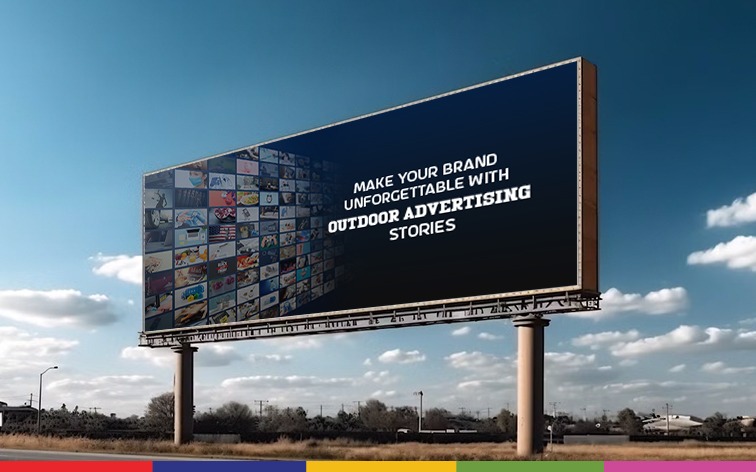Outdoor advertising is far from just putting up a sign; it is telling the story of your brand in such a way that connects with people emotionally. When done right, outdoor advertising does more than inform and captivate, it engages, and leaves people with an impression. This blog goes into a closer look at the art of storytelling in brand advertising and its role in differentiating your brand further with practical tips on how to craft a narrative, understand your audience, and find the perfect locations to get your message across.
The Power of Storytelling in Brand Outdoor Advertising
Storytelling is one of the most effective ways to connect with people. Each one can recall stories that are memorable, whether they date way back to childhood or, more recently, from an inspiring commercial or a memorable ad. Brand advertising creatively uses the art form as one approach in turning a simple message into one that people can relate to, something that tugs at your heartstrings.
Outdoor advertising, be it a billboard on a busy street or a digital ad at the airport, allows brands to paint their canvas in the presence of those people. It’s not just about the product; it’s how that product fits into the lives and emotions of the people you’re trying to reach. This is where brand storytelling through design becomes essential, as it allows you to weave your brand message in a visually engaging way.
Pro Tip: Think of the emotions you want to evoke when you think about your brand story. For a luxury car brand, sleek visuals might be sophistication and exclusivity. For a wellness brand, it’s perhaps calm, serenity-the audience looking for peace and balance.
Elements of an Awesome Brand Story
So, what makes a brand story interesting? The most successful brand stories are memorable, relatable, and emotionally charged. Here’s what goes into making one:
- Clear Message: A good story starts with clarity. Your message, therefore must clear and explicit and yet meaningful at the same time. What is it that you want to say to the audience? Here’s where you get to define the purpose of your brand and how it solves a problem or fulfills a need for your audience.
- Visual Effect: Where visuals are the heart of outdoor advertising, your image or design has to tell your story in two seconds. Whether it is a billboard hoarding or a unipole hoarding, the viewer catches the message for just a few seconds. Thus, that is what you must capitalize on. Strong visuals like an image of a happy family looking forward to a vacation or an arresting color scheme could tell your brand’s story even before any text appears.
- Emotional Connection: This is the best place to tap into the emotional side. Good stories can reach the soul—in joy, nostalgia, inspiration, or excitement.
For example, an outdoor ad for a travel company may feature an exotic beach scene that makes people dream of their next vacation. Creating the emotional connections encourages the audience to remember your brand long after they have passed by your ad. Research shows that emotions sell better than features. In fact, emotionally resonant ads are reported to perform up to two times better than those that solely focus on value propositions. “Facts tell, but feelings sell.” This is why emotive advertisements generally lead to more engagement and sales.
DYK: Research shows that emotions sell better than features. In fact, emotionally resonant ads are reported to perform up to two times better than those that solely focus on value propositions. “Facts tell, but the feelings sell.” This is why emotive advertisements generally lead to more engagement and sales.
- Authenticity: No one can trust brands anymore. That is why authenticity is the key when it comes to storytelling. Your brand story has to be authentic and real. When you try to present yourself as something you are not, your audience will catch it. Share stories that reflect what your brand stands for and its mission, and you’d have a reason for earning their trust and loyalty.
Connecting Emotions through Outdoor Advertising
One of the unique advantages of outdoor advertising is the quick, yet persistent, emotional impact that it can make. Think about it: how many times have you seen a billboard or digital sign board pass by you, and immediately, you feel a connection to the message? Outdoor ads are placed in real-world settings where your audience can truly relate to what you are trying to say.
For example, a health and wellness fitness brand could position a billboard at the local park or gym appealing to the popular desire of everything in people’s lives to be healthy. Or a family-friendly brand can put up flyers around schools or playgrounds, reinforcing safety and care messages.
The key to an emotional connection is timing and placement. It makes all the difference when you place your ads in front of people who are reflecting on your message. A well-placed shopping mall advertising or auto branding can get your brand feeling so much a part of their daily lives that they will start thinking and feeling at the right moment.
Pro Tip: You want to have an emotional angle to your outdoor campaigns. Consider Coca-Cola’s share a Coke campaign, where personalized bottles connected people’s sense of identity and belonging. That’s an emotional connection that really resonated through the campaign.
Knowing Your Audience: Demographics and Psychographics
There is no way one can tell a great story without knowing who it is to whom one tells the story. Therefore, this makes understanding the audience crucial in creating a good brand story so that you can connect with them the better, hence understanding their needs, values, and lifestyles is key to defining your target audience.
Demographics include the most elementary characteristics of your target audience, including age, gender, income levels, and location, thereby helping to understand which broad groups of people your brand might appeal to.
Psychographics takes it a little deeper in the exploration of your audience’s personality, values, and interests. This is where brand storytelling gets very personal. To understand the emotional triggers of your audience—with what excites them, challenges them—you can create a story that feels custom-built for them.
For instance, if your target market is youngsters working professionals, you could use contemporary, trendy designs and inspirational messages reflecting their energetic lifestyle. If you target families, then you might focus on security, love, and stability.
DYK: Targeting based on psychographics can increase customer engagement by as much as 35%. When you talk to people’s values and interests, they’re a heck of a lot more likely to connect to your brand.
Location Selection for Outdoor Advertising
The power of outdoor advertising lies in the selecting the right locations you make. Your message will only become effective if it finds the right place through which to see the eye of your target audience. Location selection is as important as designing a good ad.
Amplify your story with the right locations. A billboard hoarding near a busy intersection is ideal for reaching commuters, while airport advertising can target the kind of travelers who are ready for adventure or relaxation. Unipole hoarding in the cities are the perfect location to grab eyeballs with their bold designs.
Remember, placement really is everything. For example, if you have a fitness brand you want to promote, you may get better advertisements closer to the gym or near the park rather than in the residential neighborhood.
Pro Tip: Use digital sign boards in high-traffic places such as airports or shopping malls. This way, the content could change dynamically and there could easily be selective use of messages that may be time-sensitive or occasion-based.
Measuring Success: KPIs
The last step to dissemble the puzzle is to know how successful your campaign is regarding outdoor advertising. The basis of knowing whether your brand storytelling works or not relates to knowing your key performance indicators. They are helpful in checking whether your ad is targeting the correct audience and is able to meet your objectives.
Some of the most commonly used KPIs include:
- Branding: Does seeing your ads increase more people’s awareness of your brand? You can use questionnaires or tracking tools.
- Engagement: Are people taking action after viewing your ad, say, to search for your website, follow you on social media, or visit your store?
- Sales: “The final is whereby you are trying to cause sales. The ability of outdoor to lead to a purchase will determine if your storytelling was effective in causing conversions.”
For example, with geofencing and QR codes, and even mobile tracking can now provide really rich data on how people actually react to the story in real time.
Conclusion
Storytelling in outdoor advertising is not just a buzzword. It’s a well-proven means of connecting with your audience, touching their hearts, both because it speaks at the emotional level and because it creates a relation between the consumer and the brand. Understand elements of great brand story, really know your audience, and where to place the ads, you are a rock star in the crowd. Measurable KPIs let you know how your story is being received.
Therefore, the next time you are planning your campaign of outdoor advertisements, do remember: it is not merely erecting a hoarding; it is telling a tale, making people undergo an emotional chord, creating that impression long after the message has been digested.


